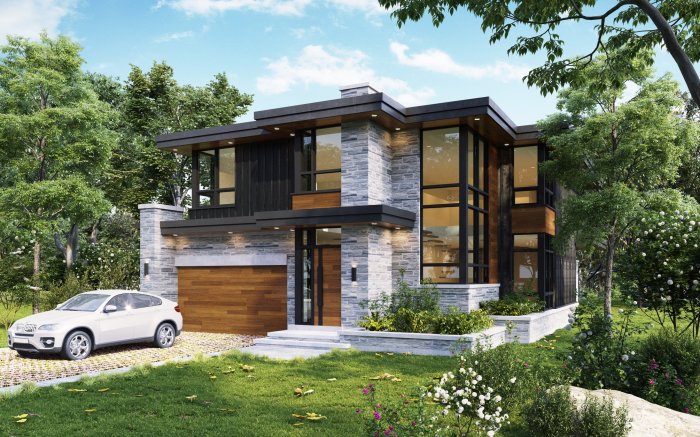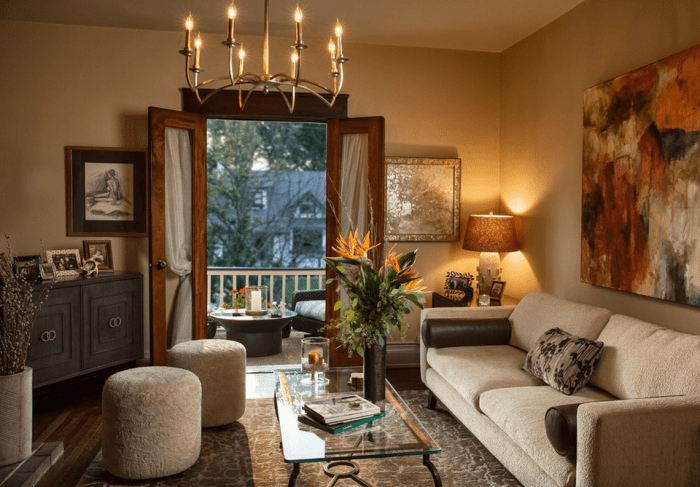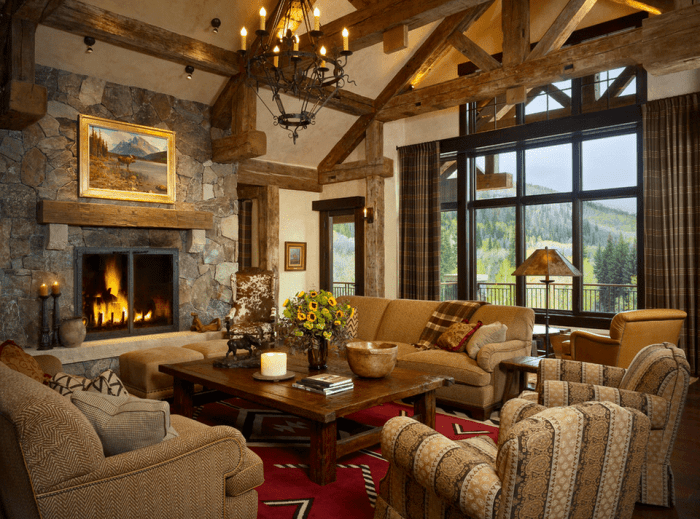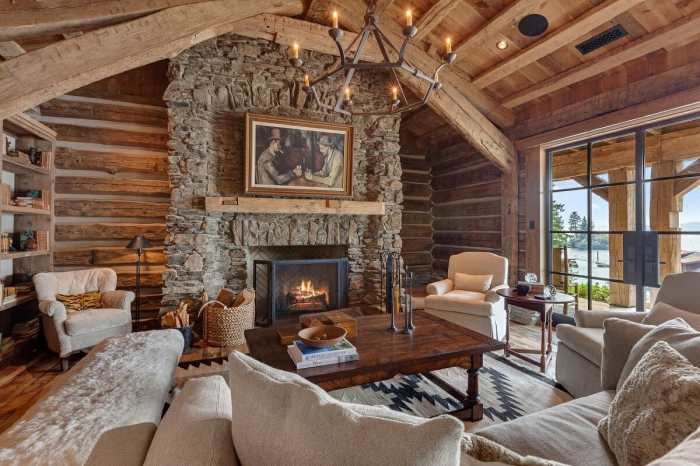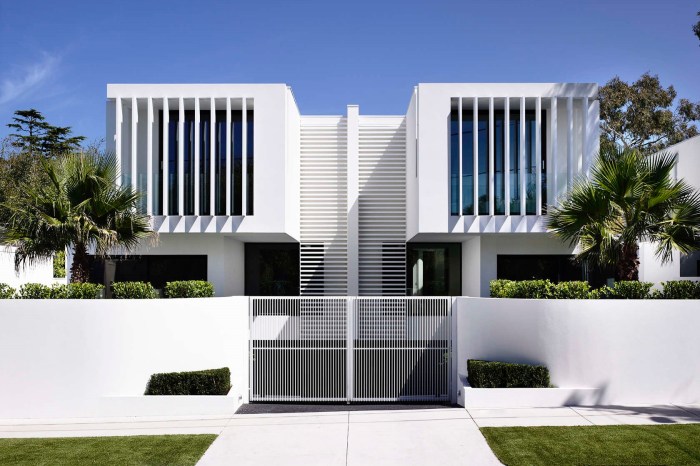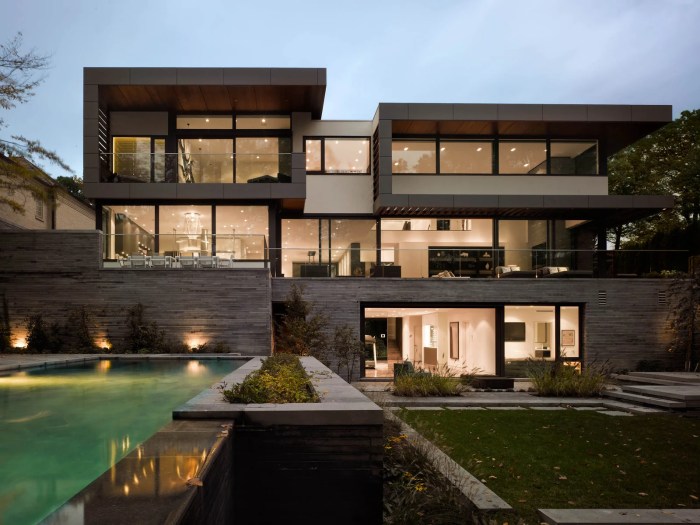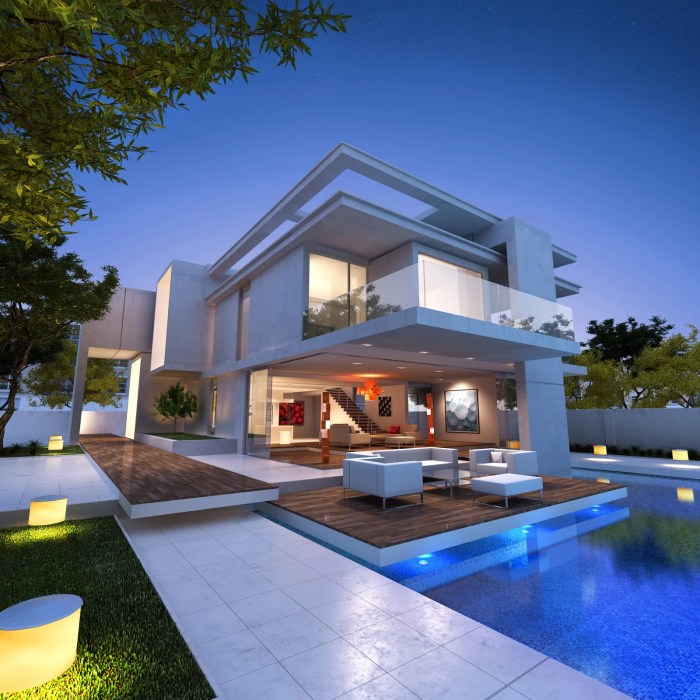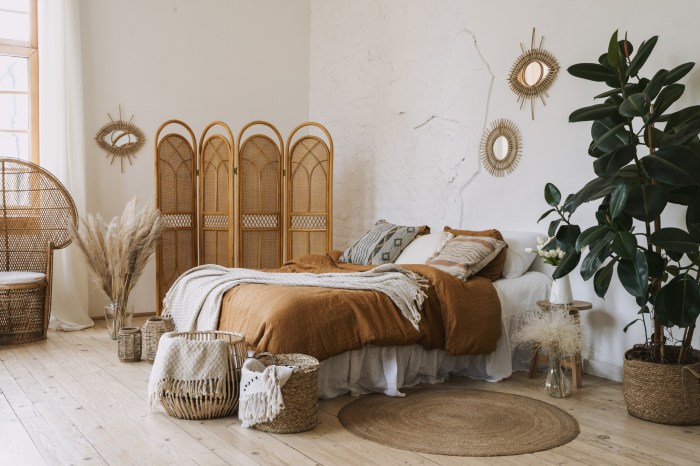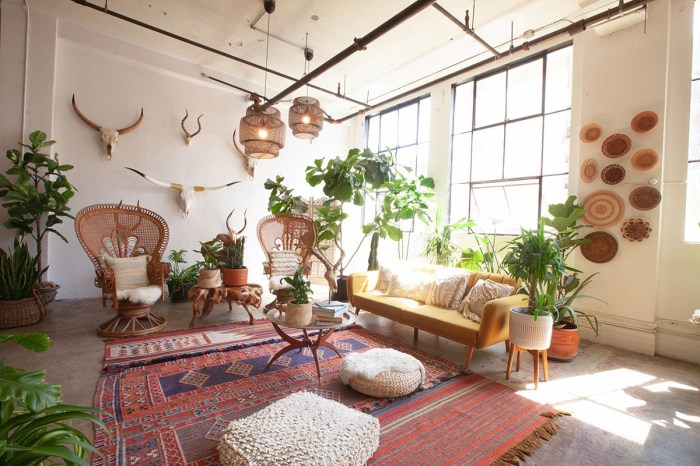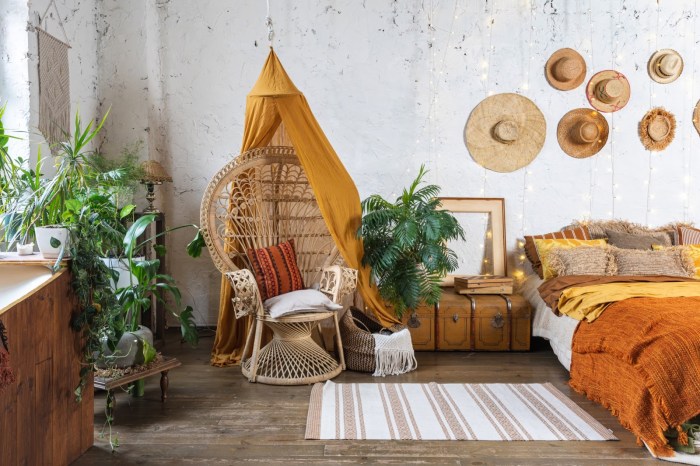Scandinavian home design, synonymous with “hygge,” transcends mere aesthetics; it’s a philosophy of light, functionality, and mindful living. Rooted in the long, dark winters of Nordic countries, this design style prioritizes maximizing natural light, utilizing natural materials, and creating a sense of warmth and comfort. This guide delves into the core principles, color palettes, lighting techniques, furniture choices, and space-saving strategies that define this increasingly popular interior design trend.
We’ll explore the historical influences, contrasting it with other styles, and provide actionable tips for incorporating Scandinavian elements into your own home, regardless of its size.
From understanding the interplay of light and shadow to selecting the perfect textures and materials, we’ll unravel the science behind creating a serene and functional space. We’ll analyze the psychological impact of color choices and the ergonomic considerations of furniture placement, demonstrating how these seemingly simple design decisions contribute to a holistic sense of well-being. The journey will reveal how Scandinavian design isn’t just about visual appeal; it’s about crafting an environment that nurtures the mind and body.
Defining Scandinavian Home Design
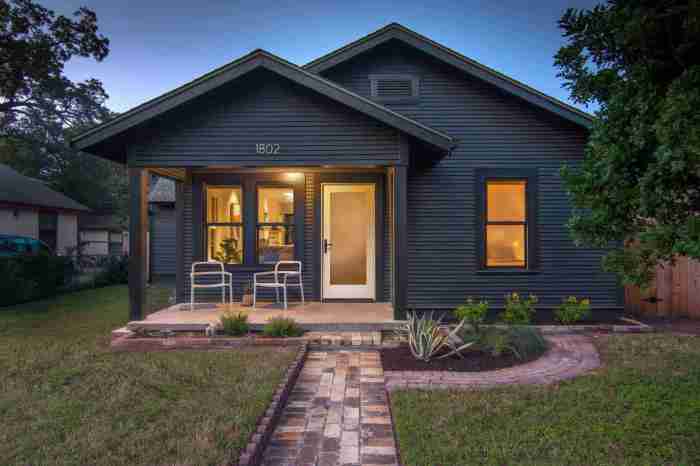
Scandinavian home design, a style deeply rooted in the cultural and environmental context of the Nordic countries, emphasizes functionality, minimalism, and a connection with nature. Its enduring appeal stems from its ability to create spaces that are both aesthetically pleasing and incredibly practical, reflecting a lifestyle prioritizing well-being and simplicity.
The core principles of Scandinavian design revolve around functionality, simplicity, and natural light. These principles are interwoven with a deep respect for nature, manifested in the use of natural materials and a color palette inspired by the Nordic landscape. The emphasis is on creating a sense of calm and serenity within the home, a sanctuary from the often harsh external environment.
Historical Influences on Scandinavian Design
Scandinavian design’s evolution is intrinsically linked to the region’s history and climate. The long, dark winters and limited sunlight of Scandinavia fostered a focus on maximizing natural light and creating cozy, inviting interiors. The functionalist movement of the early 20th century, emphasizing practicality and efficiency, significantly impacted the style. Furthermore, the post-World War II era saw a rise in affordable, mass-produced furniture, which helped democratize the Scandinavian aesthetic and spread its popularity globally.
Key figures like Alvar Aalto and Arne Jacobsen played crucial roles in shaping this aesthetic, championing simple forms and high-quality materials.
Comparison of Scandinavian Design with Other Interior Design Styles
Scandinavian design stands in contrast to many other styles. Unlike the ornate detailing of Baroque or Victorian styles, it embraces minimalism and clean lines. Compared to the opulent richness of Maximalism, it prioritizes simplicity and functionality. While sharing some minimalist tendencies with Japanese design, Scandinavian style incorporates a warmer, more inviting color palette and a greater emphasis on natural materials like wood and wool, creating a distinctly different atmosphere.
In comparison to Mid-Century Modern, Scandinavian design often leans towards softer, more organic forms and a greater integration of natural light.
Key Characteristics of Scandinavian Homes
The following table summarizes the key characteristics that define a Scandinavian home:
| Feature | Description | Example | Image Description |
|---|---|---|---|
| Light Color Palette | Predominantly whites, creams, and light grays are used to maximize the feeling of spaciousness and reflect natural light. Accents of bolder colors are often used sparingly. | Walls painted in a soft, creamy white, complemented by light gray furniture. | A depiction of a living room with off-white walls, a light gray sofa, and a white rug. Natural light streams in through large windows, illuminating the space. |
| Natural Materials | Wood, wool, linen, and cotton are favored for their natural beauty and texture, creating a warm and inviting atmosphere. | A coffee table made of light oak wood, paired with a wool throw blanket. | A close-up showing the grain of a light oak coffee table, with a soft, textured wool blanket draped over one side. |
| Minimalist Approach | Clutter is avoided, and only essential furniture and decorative items are used, creating a sense of calm and spaciousness. | A living room with a simple sofa, a few carefully chosen cushions, and a minimalist coffee table. | An image of a sparsely furnished living room, showcasing a clean-lined sofa, a single plant, and a simple coffee table, all in neutral colors. |
| Functionality | Furniture and décor are chosen for their practicality and versatility. Multi-functional pieces are common. | A sofa bed that serves as both seating and sleeping space. | A photograph of a sofa bed neatly made up as a bed, showcasing its dual functionality. |
Color Palettes and Materials
Scandinavian design, born from the long, dark winters and bright, short summers of Northern Europe, leverages light and natural elements to create interiors that are both functional and aesthetically pleasing. The color palettes and material choices are crucial in achieving this signature style, reflecting a deep connection to nature and a prioritization of simplicity and functionality. This section delves into the specific chromatic choices and material preferences that define Scandinavian home design.
The inherent simplicity of Scandinavian design is reflected in its restrained use of color. Rather than bold hues, the palette emphasizes a lightness and neutrality that maximizes the impact of natural light. This is achieved through a careful selection of muted tones, often incorporating shades found in the Nordic landscape.
Scandinavian Color Palettes
The core of the Scandinavian color palette revolves around neutrals. Off-whites, creamy beiges, and soft grays form the foundation, providing a calm and serene backdrop. These are often punctuated by subtle accents of deeper, more saturated colors, such as muted blues, greens, and even occasional pops of mustard yellow or terracotta. The overall effect is one of understated elegance, allowing natural light to flood the space and highlight the textural elements of the design.
The selection of these colors is not arbitrary; it’s scientifically linked to the human response to light and the need to compensate for the limited sunlight during winter months. The use of lighter colors reflects and diffuses available light, creating a sense of spaciousness and warmth.
Natural Materials in Scandinavian Interiors
Natural materials are fundamental to Scandinavian design. This preference stems from a deep respect for nature and a desire to create interiors that feel both cozy and connected to the outside world. Wood, in particular, plays a dominant role. Light-colored woods like birch and pine are common choices, contributing to the overall airy and bright atmosphere. Other natural materials frequently incorporated include stone, linen, wool, and leather.
These materials add texture and warmth, contributing to the overall tactile experience of the space. The use of these natural materials is not merely aesthetic; many possess inherent qualities that contribute to a healthier living environment. For example, wood acts as a natural air purifier, while linen and wool are breathable and regulate temperature.
Texture in Scandinavian Aesthetics
Texture plays a crucial role in creating the signature Scandinavian aesthetic. The interplay of different textures adds depth and visual interest to the otherwise minimalist palette. The smooth surface of a light-colored wooden floor might be contrasted with the rough texture of a hand-knitted wool throw, or the softness of a linen cushion against the cool smoothness of a marble countertop.
This careful layering of textures creates a sense of visual richness without overwhelming the space. The strategic use of textures also contributes to the overall feeling of comfort and warmth, essential in the colder climates of Scandinavia. The combination of tactile and visual elements enhances the sensory experience of the room, creating a welcoming and homely atmosphere.
Sample Scandinavian Living Room Color Palette
The following palette illustrates a balanced and harmonious approach to color and texture within a Scandinavian living room. The aim is to create a space that is both stylish and inviting, reflecting the core principles of the design style.
- Wall Color: “Cloud Dancer” – a soft, slightly grayish off-white. This provides a neutral base that maximizes light reflection.
- Sofa Fabric: A light gray linen. The natural texture of the linen adds visual interest and a comfortable feel.
- Rug Material: A natural wool rug in a muted beige tone. The wool provides warmth and texture underfoot.
- Accent Color: A muted teal blue used in throw pillows and a small decorative vase. This provides a subtle pop of color without disrupting the overall calm.
- Coffee Table Material: Light oak wood with a smooth finish. The natural wood grain adds warmth and visual interest.
Lighting and Functionality
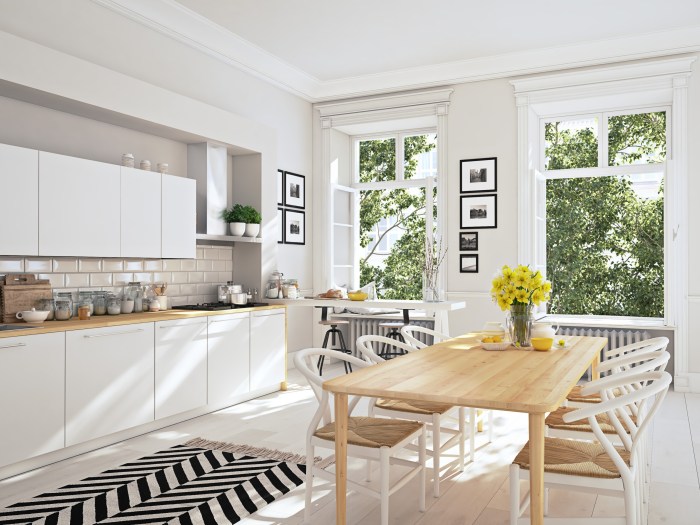
Scandinavian design prioritizes the interplay of light and functionality to create homes that are both aesthetically pleasing and highly practical. The long, dark winters of Scandinavia necessitate a keen understanding of how to maximize natural light and strategically employ artificial lighting to compensate for seasonal limitations. This approach extends to all aspects of the home, ensuring that every space is not only beautiful but also serves its intended purpose efficiently.The principles of Scandinavian design emphasize simplicity, functionality, and a connection with nature.
These principles are intrinsically linked to the way light is used and how spaces are organized to optimize daily life. A well-lit, functional home is a key component of the Scandinavian ethos, promoting well-being and a sense of calm.
Maximizing Natural Light in Scandinavian Homes
Maximizing natural light is paramount in Scandinavian design. Large windows, often floor-to-ceiling, are a defining feature, allowing abundant sunlight to flood interior spaces. This is not merely an aesthetic choice; it’s a practical response to the limited daylight hours during winter months. The scientific principle at play here is the impact of light on human circadian rhythms – exposure to natural light helps regulate sleep-wake cycles and boosts mood, combating the effects of Seasonal Affective Disorder (SAD) common in northern climates.
Further enhancing natural light penetration involves using light-colored walls and floors to reflect sunlight effectively, minimizing the absorption of light by dark surfaces. Strategically placed mirrors can also bounce light deeper into the room, creating a brighter, more welcoming atmosphere.
Suitable Lighting Fixtures for Scandinavian Interiors
Scandinavian lighting fixtures are characterized by their minimalist aesthetic and functionality. Pendant lights, often made of simple materials like glass or metal, are commonly used to provide ambient lighting. These fixtures frequently feature clean lines and unadorned designs, emphasizing the beauty of the materials themselves. Table lamps and floor lamps, often with adjustable arms, provide task lighting and accent lighting, enabling customization of light levels and directions.
Recessed lighting is another popular choice, offering subtle illumination without cluttering the space. The use of dimmers is also prevalent, allowing for adjustment of light intensity to suit different moods and activities. Natural materials like wood and linen are often incorporated into lampshades, adding warmth and texture to the overall design.
Functionality in Scandinavian Design
Functionality is a cornerstone of Scandinavian design. Every element, from furniture to lighting, serves a practical purpose. The design philosophy emphasizes simplicity and avoids unnecessary ornamentation. This approach reflects a practical and sustainable mindset, reflecting the region’s history of resourcefulness. Multi-functional furniture is a common feature; a sofa bed serves as both seating and sleeping space, while storage ottomans provide seating and concealed storage.
Open shelving and minimalist storage solutions keep spaces clutter-free and maximize functionality. This focus on functionality contributes to a sense of calm and order, crucial elements in creating a relaxing and comfortable home environment.
Layered Lighting in a Scandinavian Bedroom
Layering lighting in a Scandinavian bedroom creates a versatile and adaptable environment, catering to various activities and moods. Effective layering involves combining different types of lighting to achieve optimal illumination and ambiance.
- Ambient Lighting: A central pendant light or recessed lighting provides overall illumination, establishing a base level of brightness. This might be a simple, modern pendant light made of white glass or a sleek, flush-mounted fixture.
- Task Lighting: A bedside table lamp provides focused light for reading or other close-up activities. A minimalist design, perhaps with a linen shade, complements the overall aesthetic.
- Accent Lighting: A small, decorative lamp or wall sconce can highlight artwork or architectural features, adding visual interest and depth to the room. This could be a small ceramic lamp or a minimalist metal wall sconce.
Furniture and Decor
Scandinavian design philosophy extends beyond color palettes and lighting; it’s deeply intertwined with the careful selection and arrangement of furniture and decor. The emphasis remains on functionality, simplicity, and the use of natural materials, creating spaces that are both aesthetically pleasing and conducive to a calm, comfortable lifestyle. This section explores the key elements of Scandinavian furniture and decor, illustrating how minimalism and personal expression can coexist harmoniously.
Classic Scandinavian Furniture Pieces
The history of Scandinavian design is rich with iconic furniture pieces that exemplify the region’s commitment to craftsmanship and minimalist aesthetics. These pieces, often characterized by clean lines, simple forms, and high-quality materials, remain highly sought after today. Examples include the CH24 Wishbone Chair by Hans Wegner, renowned for its Y-shaped back and comfortable seating; the Arne Jacobsen Egg Chair, a sculptural masterpiece that epitomizes mid-century modern design; and the Alvar Aalto Stool 60, a versatile and durable stool crafted from bent plywood.
These pieces, while varying in style, share a common thread: a focus on both form and function, reflecting the practical yet elegant nature of Scandinavian design.
Minimalist Decor in Scandinavian Homes
Minimalism is a cornerstone of Scandinavian interior design. This doesn’t equate to emptiness, but rather a curated selection of items, each serving a purpose and contributing to the overall aesthetic. The emphasis is on quality over quantity, with a preference for natural materials like wood, wool, and linen. Decorative elements are often understated, focusing on texture and subtle details rather than bold patterns or vibrant colors.
Think simple ceramic vases, hand-woven textiles, and carefully chosen artwork—pieces that add character without overwhelming the space. This minimalist approach creates a sense of calm and order, allowing the natural light and the beauty of the materials to take center stage. The scientific principle of “less is more” is perfectly embodied here; reducing visual clutter reduces cognitive overload, contributing to a more peaceful and relaxing environment.
Incorporating Personal Touches While Maintaining Scandinavian Aesthetic
While minimalism is key, Scandinavian design isn’t devoid of personality. The key lies in incorporating personal touches thoughtfully, ensuring they complement rather than clash with the overall aesthetic. Family photographs displayed in simple frames, a collection of vintage books, or a cherished piece of handcrafted pottery can all add a layer of warmth and individuality without sacrificing the clean, uncluttered feel.
The secret is in the curation; choosing items that resonate personally while maintaining a consistent color palette and material selection. This balance between minimalism and personal expression creates a space that feels both stylish and uniquely reflective of its inhabitants.
Essential Furniture Pieces for a Scandinavian Living Room
The following table Artikels five essential furniture pieces for a Scandinavian living room, highlighting their style and functionality:
| Furniture Piece | Style & Functionality |
|---|---|
| Sofa | Simple lines, neutral upholstery (e.g., linen or wool), comfortable seating for relaxation and socializing. Often features a low profile and clean silhouette. |
| Coffee Table | Low-to-the-ground design, often made of wood or a combination of wood and metal, providing a surface for drinks, books, and other items. May incorporate storage. |
| Armchair | Similar in style to the sofa, offering additional seating and a comfortable spot for reading or relaxing. Could be a statement piece in a complementary fabric or color. |
| Rug | Natural fibers (e.g., wool or jute), often in neutral tones, defining the seating area and adding warmth and texture to the floor. May incorporate a subtle pattern. |
| Storage Unit | Simple design, often made of wood or light-colored laminate, providing storage for books, media, and other items, maintaining a clutter-free environment. |
Creating a Cozy Atmosphere
The inherent coziness of Scandinavian design stems from its focus on creating a haven—a space that prioritizes comfort, warmth, and a sense of well-being. This is achieved not through opulent decoration, but through a considered approach to texture, light, and the strategic incorporation of natural elements. The psychological impact of a cozy environment is well-documented, contributing to reduced stress and improved mood.
Creating this atmosphere in a Scandinavian home relies heavily on the thoughtful use of textiles, plants, and carefully placed light sources.
Textiles and Warmth
Textiles play a crucial role in softening hard surfaces and adding a layer of tactile comfort. The thermal properties of materials like wool, sheepskin, and thick cotton are scientifically proven to enhance insulation and retain heat, contributing to a warmer feeling. The use of chunky knit throws draped over sofas, plush rugs underfoot, and linen curtains that diffuse light all contribute to this sensory experience.
Consider the visual and tactile appeal of a sheepskin rug placed by a fireplace, or a woven throw in a warm neutral tone draped over a light-colored sofa. These additions don’t just add visual interest; they actively contribute to the perception of warmth and comfort.
Incorporating Plants and Natural Elements
Biophilic design, the incorporation of natural elements into the built environment, is a key aspect of Scandinavian design. Studies have shown that exposure to nature reduces stress hormones and improves cognitive function. Plants, in particular, introduce visual interest and contribute to cleaner air. Consider placing large potted plants in corners to add height and texture, or a collection of smaller plants on windowsills to maximize natural light.
The use of natural materials like wood, stone, and rattan further reinforces this connection to nature, adding a sense of authenticity and grounding the space. The visual contrast of green foliage against light walls and wooden furniture is aesthetically pleasing and creates a calming effect.
Candles and Fireplaces: Ambient Lighting
The strategic use of lighting is fundamental to creating a cozy atmosphere. Candles, in particular, provide a warm, flickering light that is both visually appealing and psychologically comforting. The soft, diffused light emitted by candles creates a sense of intimacy and relaxation, reducing the harshness of overhead lighting. Similarly, fireplaces, if available, offer a focal point that exudes warmth and comfort.
The crackling sound and the visual spectacle of a fire have a naturally calming effect, contributing significantly to the overall ambiance of the room. The interplay of candlelight and the gentle glow from a fireplace creates a truly inviting space.
Scandinavian Nursery Mood Board
A Scandinavian-style nursery would feature a calming color palette of soft greys, muted blues, and creamy whites, punctuated by accents of natural wood. The walls might be painted a soft grey, complemented by a light oak crib and changing table. A large, fluffy sheepskin rug would add warmth and texture underfoot. Soft, natural linen curtains would filter the sunlight, while a mobile featuring simple, geometric shapes in muted tones would hang above the crib. A few carefully selected plants, such as a peace lily or snake plant, would add life and contribute to clean air. The overall effect would be one of serenity and gentle warmth, creating a safe and soothing environment for the baby. The materials would be primarily natural – wood, linen, cotton, and wool – emphasizing sustainability and tactile comfort. Decorative elements would be minimal, focusing on functionality and simplicity.
Small Space Solutions for Scandinavian Design
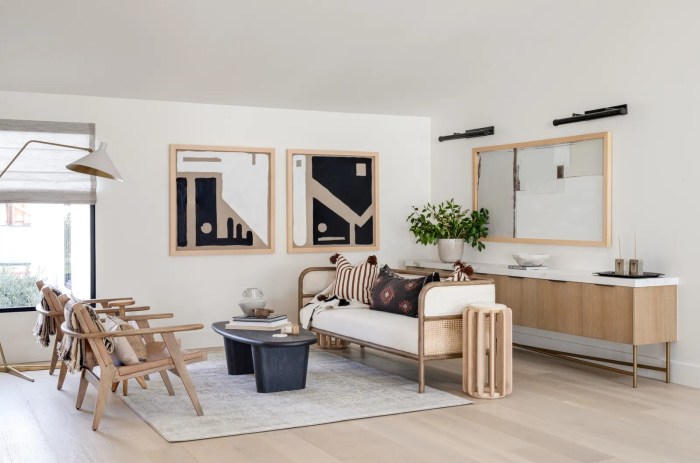
The inherent minimalism of Scandinavian design makes it surprisingly adaptable to smaller living spaces. By prioritizing functionality, light, and a carefully curated selection of pieces, even the smallest apartment can embody the clean lines and airy feel characteristic of this style. This section explores practical strategies for maximizing space and maintaining a distinctly Scandinavian aesthetic in compact homes.
Space-Saving Furniture for Scandinavian Interiors
Scandinavian design emphasizes multi-functional furniture that seamlessly blends form and function. Choosing pieces with built-in storage, such as ottomans with hidden compartments or beds with integrated drawers, significantly increases storage capacity without compromising on style. Consider using sofa beds to optimize space in living areas, or nesting tables that can be tucked away when not in use. Lightweight, easily movable furniture allows for flexible room arrangement, facilitating quick adjustments to suit different needs and maximizing usable floor space.
The use of light-colored wood, a staple of Scandinavian design, further contributes to the illusion of spaciousness. For example, a whitewashed pine dining table with built-in benches can comfortably seat four while also providing storage underneath.
Mastering Scandinavian design is about more than simply replicating a style; it’s about embracing a lifestyle. By understanding the core principles—functionality, natural light, minimalist aesthetics, and the strategic use of textures and materials—you can create a space that reflects your personal style while promoting a sense of calm and well-being. Whether you’re working with a spacious home or a cozy apartment, the principles of Scandinavian design offer a flexible framework for creating a haven of tranquility and understated elegance.
Remember, the key is to create a space that feels both beautiful and deeply personal, a sanctuary where you can truly relax and recharge.
Question Bank
What is the difference between Scandinavian and minimalist design?
While both emphasize simplicity, Scandinavian design incorporates warmth and texture through natural materials, whereas minimalism prioritizes the absence of clutter above all else, sometimes appearing stark.
Can Scandinavian design work in a hot climate?
Absolutely! The core principles of light, functionality, and natural materials translate well across climates. Adapt by choosing lighter fabrics and potentially incorporating more ventilation strategies.
How can I incorporate Scandinavian design on a budget?
Focus on repurposing existing furniture, sourcing affordable natural materials like wood and cotton, and DIY projects like painting walls or creating simple textile accents. Thrift stores and antique shops are excellent resources.
Are there any specific plants that work well in a Scandinavian-style home?
Low-maintenance plants like snake plants, ZZ plants, and peace lilies thrive in moderate light conditions, aligning well with the design’s emphasis on natural elements.
How do I choose the right lighting for a Scandinavian space?
Layer lighting using a combination of ambient (overhead), task (desk lamps), and accent (floor lamps) lighting to create a warm and inviting atmosphere, maximizing natural light sources during the day.
Read More: Kanavino.org
